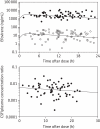Efavirenz concentrations in CSF exceed IC50 for wild-type HIV
- PMID: 21098541
- PMCID: PMC3019085
- DOI: 10.1093/jac/dkq434
Efavirenz concentrations in CSF exceed IC50 for wild-type HIV
Abstract
Objectives: HIV-associated neurocognitive disorders remain common despite use of potent antiretroviral therapy (ART). Ongoing viral replication due to poor distribution of antivirals into the CNS may increase risk for HIV-associated neurocognitive disorders. This study's objective was to determine penetration of a commonly prescribed antiretroviral drug, efavirenz, into CSF.
Methods: CHARTER is an ongoing, North American, multicentre, observational study to determine the effects of ART on HIV-associated neurological disease. Single random plasma and CSF samples were drawn within 1 h of each other from subjects taking efavirenz between September 2003 and July 2007. Samples were assayed by HPLC or HPLC/mass spectrometry with detection limits of 39 ng/mL (plasma) and <0.1 ng/mL (CSF).
Results: Eighty participants (age 44 ± 8 years; 79 ± 15 kg; 20 females) had samples drawn 12.5 ± 5.4 h post-dose. The median efavirenz concentrations after a median of 7 months [interquartile range (IQR) 2-17] of therapy were 2145 ng/mL in plasma (IQR 1384-4423) and 13.9 ng/mL in CSF (IQR 4.1-21.2). The CSF/plasma concentration ratio from paired samples drawn within 1 h of each other was 0.005 (IQR 0.0026-0.0076; n = 69). The CSF/IC(50) ratio was 26 (IQR 8-41) using the published IC(50) for wild-type HIV (0.51 ng/mL). Two CSF samples had concentrations below the efavirenz IC(50) for wild-type HIV.
Conclusions: Efavirenz concentrations in the CSF are only 0.5% of plasma concentrations but exceed the wild-type IC(50) in nearly all individuals. Since CSF drug concentrations reflect those in brain interstitial fluids, efavirenz reaches therapeutic concentrations in brain tissue.
Figures

Similar articles
-
Protein-free efavirenz concentrations in cerebrospinal fluid and blood plasma are equivalent: applying the law of mass action to predict protein-free drug concentration.Antimicrob Agents Chemother. 2013 Mar;57(3):1409-14. doi: 10.1128/AAC.02329-12. Epub 2013 Jan 7. Antimicrob Agents Chemother. 2013. PMID: 23295919 Free PMC article.
-
Efavirenz pharmacokinetics in cerebrospinal fluid and plasma over a 24-hour dosing interval.Antimicrob Agents Chemother. 2012 Sep;56(9):4583-5. doi: 10.1128/AAC.06311-11. Epub 2012 Jun 11. Antimicrob Agents Chemother. 2012. PMID: 22687515 Free PMC article.
-
Efavirenz Is Predicted To Accumulate in Brain Tissue: an In Silico, In Vitro, and In Vivo Investigation.Antimicrob Agents Chemother. 2016 Dec 27;61(1):e01841-16. doi: 10.1128/AAC.01841-16. Print 2017 Jan. Antimicrob Agents Chemother. 2016. PMID: 27799216 Free PMC article.
-
Total raltegravir concentrations in cerebrospinal fluid exceed the 50-percent inhibitory concentration for wild-type HIV-1.Antimicrob Agents Chemother. 2010 Dec;54(12):5156-60. doi: 10.1128/AAC.00507-10. Epub 2010 Sep 27. Antimicrob Agents Chemother. 2010. PMID: 20876368 Free PMC article.
-
Neurologic complications of HIV disease and their treatment.Top HIV Med. 2009 Apr-May;17(2):46-56. Top HIV Med. 2009. PMID: 19401607 Free PMC article. Review.
Cited by
-
Protein-free efavirenz concentrations in cerebrospinal fluid and blood plasma are equivalent: applying the law of mass action to predict protein-free drug concentration.Antimicrob Agents Chemother. 2013 Mar;57(3):1409-14. doi: 10.1128/AAC.02329-12. Epub 2013 Jan 7. Antimicrob Agents Chemother. 2013. PMID: 23295919 Free PMC article.
-
The HIV antiretroviral drug efavirenz has LSD-like properties.Neuropsychopharmacology. 2013 Nov;38(12):2373-84. doi: 10.1038/npp.2013.135. Epub 2013 May 24. Neuropsychopharmacology. 2013. PMID: 23702798 Free PMC article.
-
8-Hydroxy-efavirenz, the primary metabolite of the antiretroviral drug Efavirenz, stimulates the glycolytic flux in cultured rat astrocytes.Neurochem Res. 2013 Dec;38(12):2524-34. doi: 10.1007/s11064-013-1165-2. Epub 2013 Oct 4. Neurochem Res. 2013. PMID: 24091996
-
Effects of Combined CCR5/Integrase Inhibitors-Based Regimen on Mucosal Immunity in HIV-Infected Patients Naïve to Antiretroviral Therapy: A Pilot Randomized Trial.PLoS Pathog. 2016 Jan 21;12(1):e1005381. doi: 10.1371/journal.ppat.1005381. eCollection 2016 Jan. PLoS Pathog. 2016. PMID: 26795282 Free PMC article. Clinical Trial.
-
Intramuscular and subcutaneous administration of antiretroviral drugs, compared with oral, enhances delivery to lymphoid tissues in BALB/c mice.J Antimicrob Chemother. 2021 Sep 15;76(10):2651-2658. doi: 10.1093/jac/dkab228. J Antimicrob Chemother. 2021. PMID: 34312680 Free PMC article.
References
-
- Simioni S, Cavassini M, Annoni JM, et al. Cognitive dysfunction in HIV patients despite long-standing suppression of viremia. AIDS. 2010;24:1243–50. - PubMed
-
- Reddy YS, Kashuba A, Gerber J, et al. Roundtable report: importance of antiretroviral drug concentrations in sanctuary sites and viral reservoirs. AIDS Res Hum Retroviruses. 2003;19:167–76. doi:10.1089/088922203763315669. - DOI - PubMed
-
- van Praag RM, van Weert EC, van Heeswijk RP, et al. Stable concentrations of zidovudine, stavudine, lamivudine, abacavir, and nevirapine in serum and cerebrospinal fluid during 2 years of therapy. Antimicrob Agents Chemother. 2002;46:896–9. doi:10.1128/AAC.46.3.896-899.2002. - DOI - PMC - PubMed
-
- Tashima KT, Caliendo AM, Ahmad M, et al. Cerebrospinal fluid human immunodeficiency virus type 1 (HIV-1) suppression and efavirenz drug concentrations in HIV-1-infected patients receiving combination therapy. J Infect Dis. 1999;180:862–4. doi:10.1086/314945. - DOI - PubMed
-
- Antinori A, Perno CF, Giancola ML, et al. Efficacy of cerebrospinal fluid (CSF)-penetrating antiretroviral drugs against HIV in the neurological compartment: different patterns of phenotypic resistance in CSF and plasma. Clin Infect Dis. 2005;41:1787–93. doi:10.1086/498310. - DOI - PubMed
Publication types
MeSH terms
Substances
Grants and funding
LinkOut - more resources
Full Text Sources
Medical

